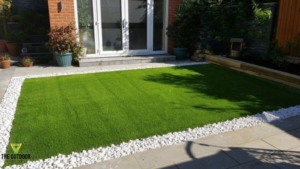Synthetic grass can transform your backyard into a lush, green oasis with minimal maintenance. However, successful installation requires careful planning and consideration. Here’s what you need to know when getting synthetic grass installed.
Benefits of Synthetic Grass
- Low Maintenance: No mowing, watering, or fertilizing needed.
- Water Conservation: Significantly reduces water usage.
- Durability: Can withstand heavy foot traffic and varying weather conditions.
- Year-Round Green: Maintains its vibrant appearance in all seasons.
- Eco-Friendly Options: Some synthetic grasses are made from recycled materials and reduce the need for pesticides and fertilizers.
Key Considerations Before Installation
- Choosing the Right Synthetic Grass:
- Quality: Opt for high-quality synthetic grass for better durability and a more natural look. Look for UV-resistant and non-toxic materials.
- Pile Height: Consider the length of the grass blades. Shorter piles are ideal for high-traffic areas, while longer piles offer a more lush appearance.
- Infill Material: Decide on the type of infill, such as silica sand, rubber granules, or a mix. Infill supports the grass blades and provides cushioning.
- Preparation and Planning:
- Measure the Area: Accurately measure the space to determine how much synthetic grass you’ll need.
- Design: Plan the layout, including any edges, curves, or additional features like pathways or flower beds.
- Drainage: Ensure proper drainage to prevent water accumulation under the turf.
- Hiring a Professional vs. DIY:
- Professional Installation: Guarantees expertise, proper tools, and a seamless finish. Consider hiring professionals if you’re not confident in your DIY skills.
- DIY Installation: Can save money but requires time, effort, and some landscaping knowledge. Ensure you have the necessary tools and follow detailed instructions.
Installation Process
- Site Preparation:
- Clearing the Area: Remove any existing grass, weeds, rocks, and debris. Ensure the surface is clean and smooth.
- Excavation: Excavate the area to a depth of about 3-4 inches to allow for the base layers.
- Weed Barrier: Lay down a weed barrier fabric to prevent weeds from growing through the turf.
- Base Installation:
- Sub-Base Layer: Fill the excavated area with a sub-base material like crushed stone or decomposed granite. Compact it thoroughly to create a solid foundation.
- Leveling: Ensure the base is level and smooth, with slight slopes for drainage.
- Turf Installation:
- Laying Out the Turf: Unroll the synthetic grass over the prepared base, allowing it to acclimate and settle.
- Cutting and Fitting: Trim the edges to fit the area precisely using a utility knife.
- Securing the Seams: Join multiple pieces of turf using seam tape and adhesive or turf staples. Make sure the seams are tight and well-hidden.
- Anchoring: Secure the perimeter of the turf with landscape spikes or nails, spaced every few inches to prevent lifting.
- Infill Application:
- Choosing Infill: Use silica sand, rubber granules, or a mix as the infill material to support the grass blades and provide cushioning.
- Distributing Infill: Evenly apply the infill material using a drop spreader or broom. Brush the turf to help the infill settle.
- Final Touches:
- Brushing: Brush the turf against the grain to lift the fibers and enhance its natural appearance.
- Inspecting: Remove any debris and inspect the area for any loose spots or imperfections.
Maintenance Tips
- Regular Brushing: Brush the turf periodically to keep the fibers upright and maintain its appearance.
- Cleaning Spills: Clean any spills or pet waste promptly to prevent staining and odor.
- Rinsing: Occasionally rinse the turf with water to remove dust and debris.
- Inspecting: Regularly check for any signs of wear or damage and make repairs as needed.
Additional Considerations
- Climate: Synthetic grass can get hot in direct sunlight, so consider adding shading elements or cooling infill if you live in a particularly hot area.
- Pets: Ensure the turf is pet-friendly and can be easily cleaned. Some synthetic grasses are specifically designed for pets.
- Warranty: Check the warranty offered by the manufacturer and installer to ensure coverage for any potential issues.
By understanding these key aspects of synthetic grass installation, you can ensure a smooth process and enjoy a beautiful, low-maintenance lawn for years to come.
12600 S Belcher Rd Suite 106A, Largo, FL 33773, USA
(888) 297-6972


Recent Comments